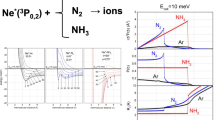Abstract
The mechanism of transitions of state (phase transitions) is examined from the viewpoint of changes in the orbital motion of molecules. It is shown that molecules move in a real gas in parabolic, hyperbolic, and linear orbits (the last are a limiting case of hyperbolic orbits). When the velocity of the molecules decreases below the parabolic velocity, transition to closed orbits — elliptical and circular — takes place, which coincides with the transition from the gaseous to the liquid state. A decrease in the velocity below the orbital circular velocity corresponds to the transition from the liquid to the solid state. The orbital parabolic velocities of molecules, which coincide with the velocities calculated with the equation from molecular-kinetic theory with a precision of ±3%, were calculated based on a comparison of a study of expansion of saturated vapor (product of the pressure by the volume) and orbital energy in the saturated state.
Similar content being viewed by others
REFERENCES
B. V. Deryagin, N. V. Churaev, and V. M. Muller, Surface Forces [in Russian], Nauka, Moscow (1985), p. 106.
A. T. Serkov, Hypotheses [in Russian], Izd. NITs Uglekhimvolokno, Mytishchi (1998), p. 125.
Author information
Authors and Affiliations
Rights and permissions
About this article
Cite this article
Serkov, A.T. On the Mechanism of Transitions of State. Fibre Chemistry 34, 162–166 (2002). https://doi.org/10.1023/A:1020506712268
Issue Date:
DOI: https://doi.org/10.1023/A:1020506712268



